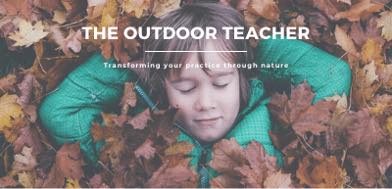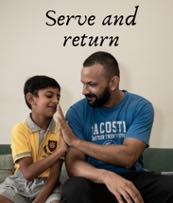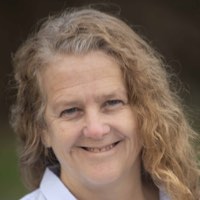Guest post
Nature as a third teacher: Play cues and returns
Guest post by Marina Robb, The Outdoor Teacher
The more that time goes on, the more I value nature as a third teacher!
There is this dynamic when we work outdoors with someone else, that is influenced by the context of nature – the three aspects being: the adult practitioners, the client or ‘young person/s’ and the natural world. As everything is actually alive and changing, they all affect each other’s experience of the moment.
Nature is our natural habitat and there is something, often below conscious awareness that allows us to encounter our natural selves. Usually being outdoors is a very pleasant experience, one which millions of people seek out for their own mental well-being. ‘Our natural self’ is the larger self that is absorbing and interacting through the senses with the external world. It includes the air we breathe and how touching a natural material may sooth or scare us!
In many ways our role as early years nature-based practitioners is to protect a particular time and space for the children, whilst they explore and play. Perry Else and Gordon Sturrock (1998) coined the term, Play Cycle and offered us terms such as play ‘cue’ and ‘returns’ for us to become more effective in our interactions with children’s play.
Cue: A lure or an invite
Return: The response

In this piece of writing, I am playing with their ideas of ‘cues’ and ‘returns’ to try to demonstrate how this is happening all the time when we are in nature. Often in human to human relationships, we value how that interaction may bring us a new piece of knowledge, or help us to feel emotionally safe and we accept in education that an adult will transfer knowledge to or teach something to a younger person. There is a general understanding in child development that there is an ongoing ‘serve and return’ between children and their carers – allowing for healthy emotional attachment.

What is less understood or valued is how the natural world also ‘returns’ our ‘cues’ and offers a vast spectrum of learning. This relationship ‘returns’ and grows our intellectual, physical, emotional and spiritual selves. As a child slips in the mud, the ‘return’ is multifaceted – from building of muscles, to the coolness of the mud, to the increase in bacteria in their gut, to emotional resilience. Nature as the teacher, is quite a complex, wise and far-reaching guide!
And nature is also full of ‘cues’. The temptation to climb the boughs of the tree, the taste of a black berry, the sensation of safety hidden in a secret place, the drops of water on our faces – and what is our ‘return’? We can interact, have a dialogue, transform it, fight and destroy it, or honour and cherish it. We can neglect and love it. We can transform what feels stuck into something that begins to flow and once again change occurs. In neuroscience we talk about mirror neurons, where we learn through imitation. In the natural world we experience that life has a cycle with beginnings and endings and is changing. From this we hopefully feel comfort with this common ground.
Nature as a teacher is almost the ideal role model – available and non-judgemental, a wonderful listener and seemingly generous and unconditional. For many of us, and I include myself who have struggled with humans at different points, nature is a reservoir of refuge. Nature speaks in metaphors and the language of feeling and we often find ourselves feeling this love – the cue is love and the return is love. This forms what we could call healthy place attachment, so that to be a healthy person we are healthily attached to ourselves, others and the natural world.
At the simplest, this is the basis of the model that I work with as a nature practitioner. That the most important invitation is to be what we are.
“Everything in nature invites us constantly to be what we are.” (Gretel Ehrlich)
This means that ideally, the space we offer is welcoming of difference and that we are watching closely for these ‘cues’ and ‘returns’ and do not assume that we are here to fill people up with knowledge, rather to encourage this intrinsic exploration, and to protect, as much as possible, that space from external agendas. All the time being mindful of this dynamic between the practitioners, the clients and the natural world and watching what wants to emerge.
I have always been interested in other cultures’ views of the human and natural world and how they approach community and nature. A nature-centric model as seen below helps us to frame human life within a wider natural world. It simplifies to me how a child, or a young animal needs to learn through this ‘serve’ and ‘return’ relationship and how nature, the context for our life, constantly provides this education.
Reference
Sturrock, G and Else, P (1998) ‘The playground as therapeutic space Playwork as healing’ (known as “The Colorado Paper’), available as part of the Therapeutic Reader One (2005) Southampton: Common Threads: https://ipaewni.files.wordpress.com/2016/05/colorado-paper.pdf
Find out more about the Play Cycle from Dr Pete King on Early Years TV here
Find out more about Marina Robb, The Outdoor Teacher, by clicking here or visiting their website here: https://www.theoutdoorteacher.com/
Meet the Author

Marina Robb has more than 30 years of experience in outdoor learning and nature connection and is the founder and Managing Director of Circle of Life Rediscovery Community Interest Company and The Outdoor Teacher Ltd, both leading organisations that aim to transform education and health through nature.
Marina’s book, Learning with Nature, foreworded by Chris Packham, is considered a must-have book for Forest School & Outdoor practitioners. Her second book, The Essential Guide to Forest School and Nature Pedagogy, published in 2021, contains everything you need to know from theory to practice.
Kathy Brodie
https://www.kathybrodie.com/author/kathy-brodie/Kathy Brodie is an author, Early Years Professional and Trainer specialising in online training and courses. She is the founder and host of the Early Years Summit and Early Years TV, weekly Professional Development for Early Years practitioners and educators.
